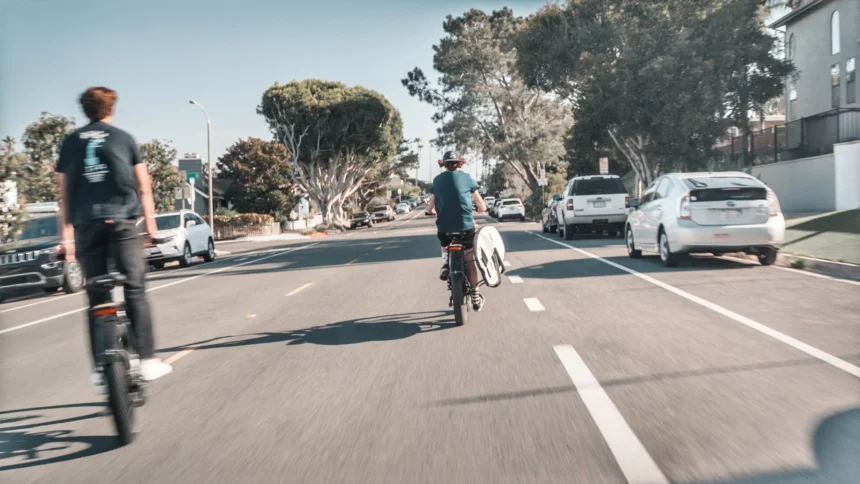As e-bikes and e-scooters gain popularity, cities are grappling with how to balance their convenience with public safety. The City of Coronado has implemented new laws aimed at reducing accidents and ensuring safety for both riders and pedestrians. These rules came into effect at the start of the year and represent a significant shift in how motorized devices are regulated in the area.
Key Changes Under the New Law
- Restricted Areas E-bikes and e-scooters are now prohibited from several key locations, including:
- Sidewalks: These spaces are reserved for pedestrians, and the presence of motorized devices can lead to collisions and injuries.
- Beaches: Popular relaxation spots like Coronado’s beaches are now off-limits for e-bike riders, ensuring a serene environment for visitors.
- Parks: These areas are designed for recreation and family activities, and the restriction aims to keep them safe for all.
- Popular Tourist Spots: High-traffic areas such as the vicinity of Hotel del Coronado are now restricted to prevent accidents in crowded spaces.
- Age Restrictions A recent bill introduces new age limits for operating certain types of e-bikes:
- Under-12 Ban: Riders under the age of 12 are no longer allowed to operate Class 1 or Class 2 e-bikes. These bikes include pedal-assisted and throttle-assisted models capable of speeds up to 20 mph.
- Enhanced Safety Measures for Minors: The decision to impose age restrictions reflects concerns about younger riders’ ability to handle these vehicles safely in traffic-heavy areas.
- Public Safety Focus Officials emphasize that the primary goal is to reduce accidents, particularly those involving children riding on streets. Coronado residents have expressed concerns about the risks posed by cars and the limited availability of safe riding spaces. These restrictions are a proactive step toward minimizing injuries and fatalities.
Why These Changes Are Necessary
The surge in popularity of e-bikes and e-scooters has brought with it a spike in accidents. Public safety officials cite several reasons for the new restrictions:
- Increased Traffic Risks: With more motorized devices sharing streets and sidewalks, the likelihood of collisions has risen. Cars, pedestrians, and riders often struggle to coexist in busy urban settings.
- Vulnerable Populations: Children, who often lack the judgment and skills required to navigate traffic safely, are particularly at risk. The restrictions aim to protect these vulnerable groups from potential harm.
- Pedestrian Safety: Sidewalks and other pedestrian zones need to remain safe for foot traffic. The presence of fast-moving devices like e-bikes can disrupt the flow and endanger pedestrians.
- Environmental Concerns: While e-bikes are eco-friendly alternatives to cars, their popularity has led to overcrowding in certain areas, creating a need for regulated zones.
Transition Period and Penalties
To help the community adjust to these changes, officials have implemented a 60-day grace period during which violators will receive warnings instead of fines. This period is intended to educate the public about the new rules and encourage compliance without immediate penalties.
After this initial phase, riders who fail to comply with the new rules could face fines of up to $100. Repeat offenders may encounter stricter consequences, including higher fines or confiscation of their devices.
Community Reactions
Many residents support the new measures, citing the need to protect children and ensure safe coexistence between riders and pedestrians. However, there are also concerns about the limited options for safe riding areas.
“My biggest concern is making sure that the kids are safe. There’s not really too many areas, especially here in Orange, where you can be safe with the bike in the street,” said a concerned resident.
While the rules may seem restrictive, they aim to encourage responsible riding and reduce the risk of accidents. Some residents have suggested creating dedicated bike lanes or expanding current infrastructure to accommodate the growing number of e-bike users.
Broader Implications
Coronado’s new e-bike regulations could set a precedent for other cities dealing with similar challenges. As urban areas face increased demand for alternative transportation options, local governments may look to Coronado’s policies as a model. Potential outcomes include:
- Improved Infrastructure: Cities may invest in dedicated bike lanes and safe zones for motorized devices to ensure harmony between riders and pedestrians.
- Nationwide Regulations: If similar measures prove successful, they could inspire state or federal guidelines for e-bike use.
- Technology Enhancements: Manufacturers may respond to these regulations by introducing features such as speed limiters or enhanced safety mechanisms for younger riders.
Tips for E-Bike Riders
To comply with the new laws and ensure a safe riding experience, e-bike enthusiasts should keep the following tips in mind:
- Know the Rules: Stay informed about local regulations to avoid fines and ensure safe riding practices.
- Use Protective Gear: Always wear helmets and other protective equipment to minimize injuries in case of accidents.
- Avoid Restricted Areas: Respect the new rules by steering clear of sidewalks, parks, and other prohibited zones.
- Ride Responsibly: Maintain a safe speed, be mindful of pedestrians, and avoid reckless maneuvers.
- Advocate for Change: Join community discussions about creating more bike-friendly spaces and suggest solutions to local officials.
Looking Ahead
The new laws in Coronado highlight the growing pains of integrating motorized devices into urban environments. By prioritizing public safety and implementing age restrictions, the city hopes to foster a safer community for everyone. However, these measures also call attention to the need for better infrastructure and more comprehensive solutions.
As more cities consider similar regulations, riders, policymakers, and manufacturers must collaborate to strike a balance between innovation and safety. For e-bike enthusiasts, these changes underscore the importance of being mindful of local laws and riding responsibly.
Coronado’s new e-bike regulations are a clear sign of the challenges posed by rapid technological adoption in transportation. By focusing on public safety, the city is taking a proactive approach to reduce accidents and protect vulnerable populations. For riders, adapting to these changes and advocating for safer infrastructure will be key to ensuring the continued growth of e-bike usage in a responsible and sustainable manner.







